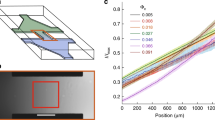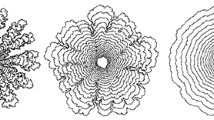Abstract
WHEN chemotactic strains of the bacterium Escherichia coli are inoculated on semi-solid agar containing mixtures of amino acids or sugars, the cells swarm outwards in a series of concentric rings: they respond to spatial gradients of attractants generated by uptake and catabolism1–3. Cells also drift up gradients generated artificially, for example by diffusion from the tip of a capillary tube4 or by mixing5. Here we describe conditions under which cells aggregate in response to gradients of attractant which they excrete themselves. When cells are grown in semi-solid agar on intermediates of the tricarboxylic acid cycle, they form symmetrical arrays of spots or stripes that arise sequentially. When cells in a thin layer of liquid culture are exposed to these compounds, spots appear synchronously, more randomly arrayed. In either case, the patterns are stationary. The attractant is a chemical sensed by the aspartate receptor. Its excretion can be triggered by oxidative stress. As oxygen is limiting at high cell densities, aggregation might serve as a mechanism for collective defence.
Similar content being viewed by others
References
Adler, J. Science 153, 708–716 (1966).
Nossal, R. Expl Cell. Res. 75, 138–142 (1972).
Wolfe, A. J. & Berg, H. C. Proc. natn. Acad. Sci. U.S.A. 86, 6973–6977 (1989).
Adler, J. Science 166, 1588–1597 (1969).
Dahlquist, F. W., Lovely, P. & Koshland, D. E. Jr Nature new Biol. 236, 120–123. (1972).
Berg, H. C. Cold Spring Harbor Symp. quant Biol. 55, 539–545 (1990).
Macnab, R. M. in Escherichia coli and Salmonella typhimurium: Cellular and Molecular Biology Vol. 1 (eds Neidhardt, F. C. et al.) 732–759 (American Society for Microbiology, Washington, DC, 1987).
Qu, Y. & Adler, J. Proc. natn. Acad. Sci. U.S.A. 86, 8358–8362 (1989).
Mesibov, R. & Adler, J. J. Bact. 112, 315–326 (1972).
Neidhardt, F. C., Ingraham, J. L. & Schaechter, M. Physiology of the Bacterial Cell Ch. 7 (Sinauer Associates, Sunderland, MA, 1990).
Berg, H. C. & Turner, L. Nature 278, 349–351 (1979).
Halliwell, B. & Gutteridge, J. M. C. Free Radicals in Biology and Medicine (Oxford University Press, Oxford, 1985).
Storz, G., Tartaglia, L. A., Farr, S. B. & Ames, B. N. Trends Genet. 6, 363–368 (1990).
Berg, H. C. & Turner, L. Biophys. J. 58, 919–930 (1990).
Berg, H. C. & Purcell, E. M. Biophys. J. 20, 193–219 (1977).
Losick, R. & Shapiro, L. Microbial Development (Cold Spring Harbor Laboratory, New York, 1984).
Shimkets, L. J. & Kaiser, D. J. Bact. 152, 451–461 (1982).
Gerhart, J. Trends Genet. 5, 233–236 (1989).
Oster, G. F. & Murray, J. D. J. exp. Zool. 251, 186–202 (1989).
Miller, J. H. Experiments in Molecular Genetics 431 (Cold Spring Harbor Laboratory, New York, 1972).
Wolfe, A. J., Conley, M. P., Kramer, T. J. & Berg, H. C. J. Bact. 169, 1878–1885 (1987).
Parkinson, J. S. J. Bact. 135, 45–53 (1978).
Author information
Authors and Affiliations
Rights and permissions
About this article
Cite this article
Budrene, E., Berg, H. Complex patterns formed by motile cells of Escherichia coli. Nature 349, 630–633 (1991). https://doi.org/10.1038/349630a0
Received:
Accepted:
Issue Date:
DOI: https://doi.org/10.1038/349630a0
- Springer Nature Limited
This article is cited by
-
Self-enhanced mobility enables vortex pattern formation in living matter
Nature (2024)
-
Spatial structure, chemotaxis and quorum sensing shape bacterial biomass accumulation in complex porous media
Nature Communications (2024)
-
On the reaction–diffusion type modelling of the self-propelled object motion
Scientific Reports (2023)
-
On a Two-Species Attraction–Repulsion Chemotaxis System with Nonlocal Terms
Journal of Nonlinear Science (2023)
-
Interactive agential dynamics
Synthese (2023)





